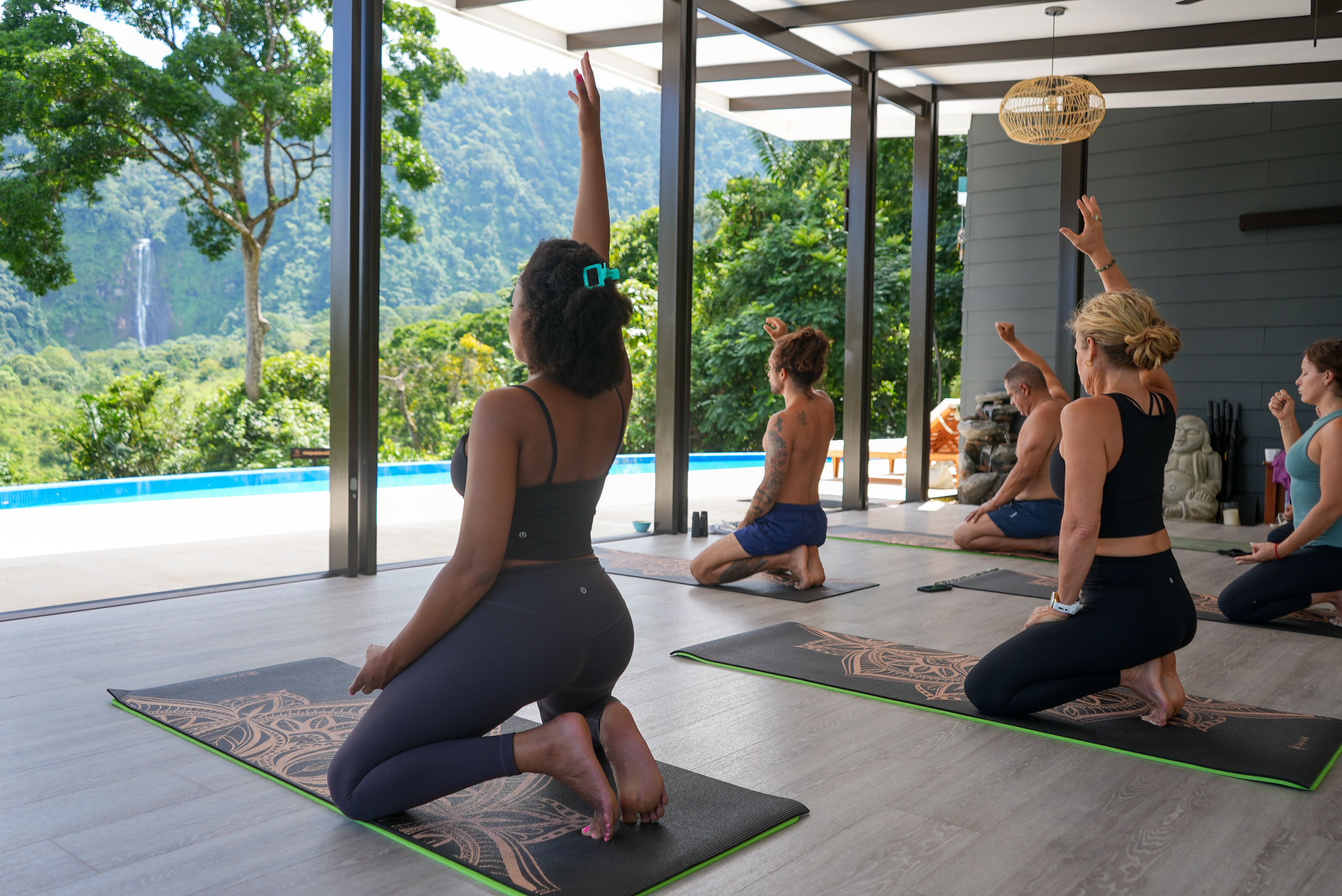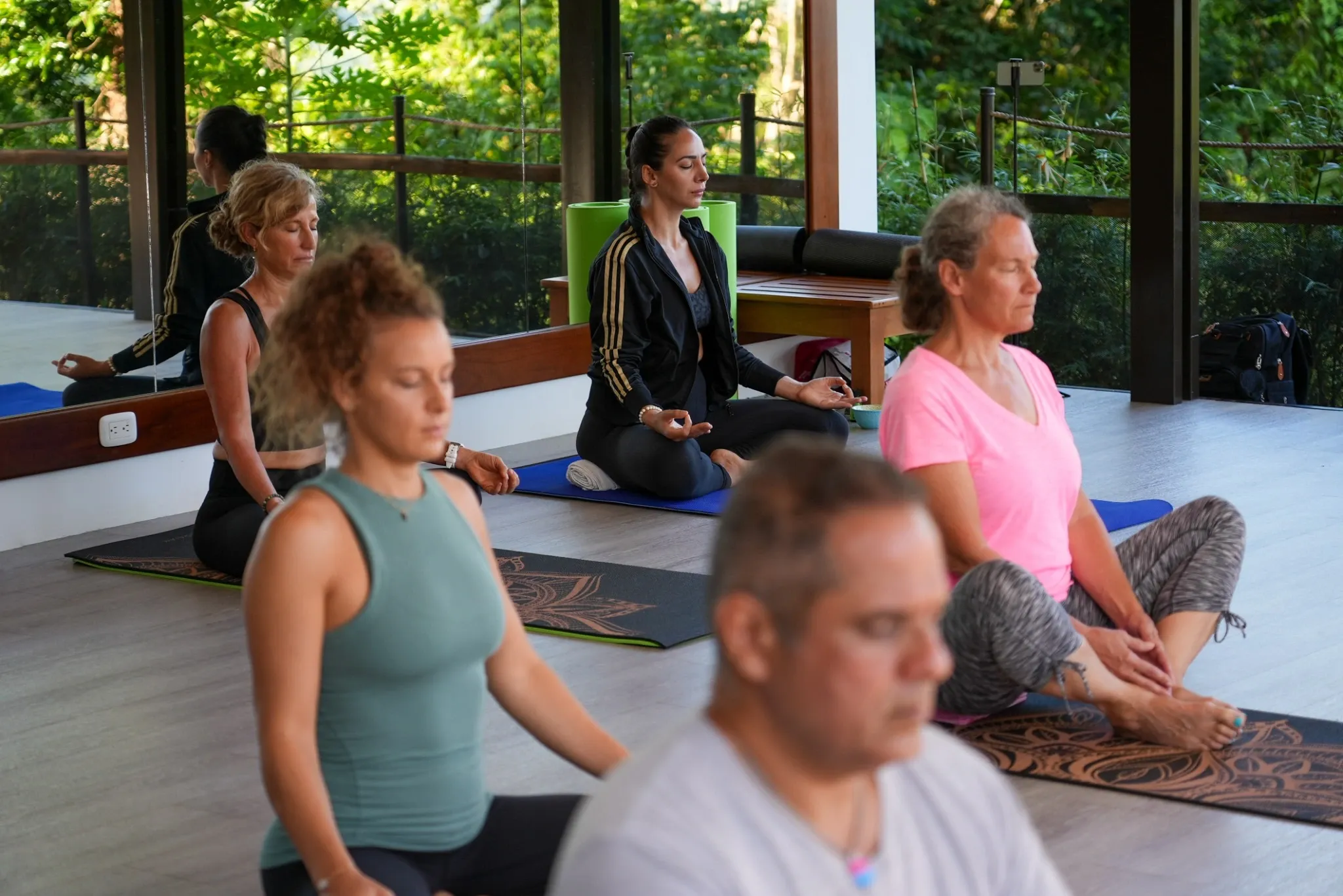2025-11-14
The Eight Limbs of Yoga: Practicing Yoga Every Day
Exploring the eight limbs of yoga, as found in the yoga sutras, and how to apply them to your practice.
 954-694-6479
954-694-6479How much time out of your daily life do you spend practicing yoga? Some people may set aside time for daily practice every day, while others might only feel like they have time to practice during a weekly class. But did you know that you can incorporate yoga into virtually every facet of your day? This is possible because the practice of yoga extends far beyond postures and breathwork. There are many ways to understand yoga beyond the physical practice, but one of the oldest and most popular is the eight limbs of yoga.
What Are the Eight Limbs of Yoga?
The eight limbs of yoga describe eight different aspects of yoga practice. These aspects were compiled by the sage Patanjali sometime around 200 BCE in a text known as the Yoga Sutras, which are central to the history of yoga. By name, the eight limbs of yoga are:
- Yama, which includes five different types of restraint or self-control.
- Niyama, which includes five different personal moral values.
- Asana, reflected in the yoga poses which make up most of the public perception of yoga.
- Pranayama, or breathwork.
- Pratyahara, practicing freedom from distraction, disengaging from the physical world and focusing attention inwards.
- Dharana, practicing concentration, by focusing on a singular point.
- Dhyana, practicing meditation, the next evolution from dharana.
- Samadhi, a state of bliss and focus, the goal of meditation.
Engaging in any of these eight aspects with intention can be considered a form of yoga practice, making it possible for you not only to practice yoga more frequently, but also for to practice more holistically.
Exploring the Eight Limbs
To better understand Patanjali’s eight limbs of yoga and how to practice them, we’ll explore each one in more detail below. Do note, however, that there is more to the yoga sutras of Patanjali, and to yoga as a whole, than just these eight concepts. At the end of this blog, we’ll discuss some more ways to expand your knowledge and broaden your practice.
Yama
The first of the eight limbs of yoga, the five yamas are commonly known as “restraints.” Each of the yamas is an ethical priority which requires intentional self-control. You can think of this limb of yoga as an ethics defined primarily by actions you don’t take.
Let's explore each of the five yamas below.
Ahimsa
The first of the restraints listed under this limb of yoga is ahimsa, which can be translated to “non-harming,” or “non-injury.” Ahimsa is all about conducting yourself in such a way to avoid bringing harm to others.
As with any idea expressed in the Sutras, ahimsa has no rigid definition or strict set of rules. It is up to the individual to reflect on the idea of non-harming and how to incorporate it into their own practice. Some ways that other yogis have practiced ahimsa include:
- Managing anger and refraining from violent or bitter thought patterns
- Adopting a vegetarian or vegan diet to avoid harming animals
- Prioritizing environmental consciousness to avoid doing harm to the planet
Satya
Satya, the second of the five yamas, emphasizes truthfulness and sincerity. When you speak and act in accordance with satya, you do so honestly.
Note that each of the yamas builds on each other, creating a more complete framework for interacting with the world around you in an ethical way. As such, many yogis emphasize that satya should not come at the expense of ahimsa—that is, if you believe that speaking the truth will do harm, some suggest that you should refrain from saying anything (think of the old adage, “if you can’t say something nice, don’t say anything at all”).
Some other ideas about incorporating satya into your daily life include:
- Acknowledging your genuine emotions even when it’s uncomfortable
- Recognizing your own desires and following them, rather than giving in to peer pressure
- Verifying information before sharing it to avoid spreading false rumors or misinformation
Asteya
Asteya essentially means “non-stealing,” which, of course, means that one should refrain from taking things which do not belong to them. However, it can extend beyond this, and there is more than one way to practice asteya in daily life, including:
- Refusing to take undue credit or plagiarize from others
- Respecting the physical and emotional boundaries of others
- Using only what you need and avoiding wastefulness
Brahmacharya
Direct translations of brahmacharya might refer to it as “continence” or “chastity,” but a more modern interpretation of this yama might be “conservation” or “moderation.” Practicing brahmacharya can mean abstaining from overindulgence of all kinds. Here are some examples:
- Avoiding excessive drinking, smoking, or other forms of consumption
- Maintaining a healthy work-life balance
- Tracking and managing time spent scrolling on social media
Aparigraha
The fifth and final restraint of the yamas is aparigraha, “non-grasping.” This can be thought of as abstaining from greed or covetousness, and even more broadly as rejecting materialism and greed.
This concept helps one to detach themselves from relying on material things, an important precursor to transcendence. Here are a few ways you can practice aparigraha in daily life:
- Setting aside time to reflect on things to be grateful for
- Clearing out clutter, both unneeded physical items and unhelpful emotional burdens like resentment or bitterness
- Finding a charitable cause to support
Niyama
The second of the eight limbs of yoga, the niyamas, goes hand-in-hand with the yamas. Instead of “restraints,” the niyamas are often called “observances.” While the yamas indicate certain behaviors to avoid, the niyamas indicate certain moral principles to uphold. Moreover, while the yamas center on how we relate to our surroundings, the niyamas are more inwardly-focused.
With this said, there is much overlap between the yamas and the niyamas, and aligning with one of these limbs is a good way to facilitate the other. There are five niyamas in the yoga sutras of Patanjali. Let’s look at each one individually:
Saucha
Saucha is usually referred to as an observance of “cleanliness.” While maintaining an orderly and uncluttered physical space could be one aspect, it also means prioritizing cleanliness in other aspects of life.
Some ways to practice mental and emotional cleanliness could include letting go of petty grudges and releasing negative emotions like anger and anxiety. One question you could reflect on when trying to prioritize saucha is: “What am I holding onto that doesn’t align with the life I want to live?”
Santosa
The second niyama is santosa, “contentment.” This one is fairly self-explanatory. It can be easy to focus on your troubles or the areas where you feel your life is lacking. However, this negative frame of mind does us very little good.
Of course, while a part of practicing contentment means celebrating what you already have, this does not mean you cannot have any wishes or desires. Rather, it’s important to avoid being letting those desires diminish the value of the present. A question you might ask yourself to help prioritize santosa is: “What do I appreciate about who and where I am today?”
Tapas
Tapas can be one of the more difficult niyamas to understand at first glance. One of the more literal translations you may see is “heat,” though some might refer to it as “austerity” or “discipline.” The primary focus of tapas is perseverance and a willingness to endure discomfort.
Of course, this doesn’t mean you should be putting yourself in active pain. Think of it as the opposite of complacency—pushing past anxious thoughts or fear of momentary discomfort to pursue growth. One question you could ask yourself while reflecting on tapas is: “How can I expand my comfort zone?”
Svadhyaya
The fourth of the niyamas is svadhyaya, which is sometimes interpreted primarily as studying of yogic texts. However, especially in modern usage, this observance is also frequently understood as “self-study.” Rather than placing the focus specifically on what and how you study, this understanding centers on a primary goal: a greater understanding of your own self.
Of course, spending time reflecting on traditional yogic texts can be a great way to achieve this, but there are also plenty of other ways to gain a deeper knowledge of yourself. From self-help, to fiction, to poetry, to even visual art, there are all kinds of works out there which can provoke us to reflect inwards. What’s important is finding what connects with you on a deeper level.
One question you might ask yourself to direct you to svadhyaya is: “What types of art and literature tend to speak to me, and why?”
Ishvara Pranidhana
Last but certainly not least is ishvara pranidhana, an idea which is often expressed as a form of surrender to the divine. Among the niyamas, this is perhaps the concept which is most difficult to grasp in a concrete way.
First and foremost, this surrender doesn’t necessarily have to be any specific deity. While ishvara pranidhana could manifest as devotion to one specific higher power, there are less direct ways to express surrender.
A helpful way to think about it is giving up the need for control, allowing peace to take hold over anxiety. This doesn’t mean you shouldn’t make your own choices, but those choices should be made with intention, in service of whatever path you want to be on. You might ask yourself: “What outside influences am I giving control to that I don’t want to be influenced by? How can I let go of these influences?”
Asana
Asana is likely the most well-known of the eight limbs of yoga, the source of what we know as yoga poses. The foundation of asana is posture, important to maintain balance and groundedness.
With the prevalence of yoga poses in modern practice, there are a great many ways to practice asana, from seated poses to acro-yoga, and even yoga poses for 2 people. But despite their dominance, asana only makes up part of the physical practice of yoga, and the next limb of yoga is equally important to ground and center oneself.
Pranayama
While the posture-focused practice of asana is crucial to provide a physical foundation, there is another physical practice which is necessary to help you calm your mind and achieve both physical and mental balance. This is pranayama—breathwork—the fourth limb of yoga.
The primary goal in this limb is to maintain steady breathing. By maintaining a steady physical posture and physical breathing, you can then focus your mind for the remaining four limbs of yoga.
Pratyahara
Once the body and mind are at ease, and you are in a comfortable, relaxed, position where you don’t need to move, you are primed for the fifth limb of yoga: pratyahara, withdrawing your senses.
As human beings, we tend to be very reliant on our physical sense to understand the world around us and how we relate to it. However, the yoga sutras of Patanjali encourage us to understand ourselves beyond our physical body and senses. Thus, the practice of pratyahara involves focusing attention inward and allowing yourself to let go of that reliance on outward senses.
Dharana
The five preceding limbs of yoga all serve to prepare for the final three limbs, which flow neatly into one another. The first of these three limbs is dharana, concentration on a single point. Having aligned yourself in the yamas and niyamas, set a steady physical foundation in asana and pranayama, and withdrawn from sensory distraction through pratyahara, you have now primed yourself to focus your entire attention on one point in space.
You can choose to focus on any singular point in the area, perhaps finding a small object or mark to direct your attention towards. What matters is practicing pure concentration, which will set you up for the seventh limb of yoga.
Dhyana
Dhyana, the seventh of the eight limbs of yoga, is typically translated as “meditation.” Having practiced pure concentration through dharana, you can transition into a deep inward reflection. Though there are many ways to meditate, the preceding six limbs of yoga provide an essential framework to prime the mind for dhyana, which in turn prepares you for the eight and final limb of yoga as established in the yoga sutras of Patanjali.
Samadhi
The eighth and final limb of yoga is samadhi, which can be considered the ultimate state of concentration and the destination which the other seven limbs carry you towards. The word samadhi can be translated to mean “communion” or “coming together,” and appropriately, it is built on harmony between body, mind, and spirit. This harmony allows you to reach a more peaceful, introspective, and balanced state of consciousness.
What Next?
Though we have explored each of the eight limbs of yoga one by one in this blog, it is safe to say that we’ve barely scratched the surface. If you are looking to expand your yoga practice in a holistic direction, there are many paths you can take.
Further Studies
One way to increase your knowledge and apply your practice is to read and reflect on the historical texts of the yogic tradition, including the yoga sutras of Patanjali, but also the Rigveda, the Bhagavad Gita, and many more. In addition, many yogis and scholars have published their own commentaries on these texts, allowing you to engage on a deeper level with helpful context and insights from other voices.
Attend Yoga Teacher Training
Another step you can take to broaden your experience and understanding with yoga is to attend a 200-hour yoga teacher training course. Even if you have no plans of teaching your own yoga class, yoga teacher training is an excellent opportunity to eat, breathe, and sleep yoga with other avid learners.
Attend a Yoga Retreat
Lastly, if you’re looking for an opportunity to get away from the stress and distraction of everyday life so you can focus on applying yoga principles more holistically, why not host or attend a yoga retreat? In addition to the opportunity to expand your yoga practice, a yoga retreat can also be a perfect time to relax and renew.
Yoga Retreat Centers in Costa Rica
Costa Rica is home to serene natural landscapes which provide the perfect environment for yoga practice, and its commitment to sustainability has made it one of the best eco-friendly travel destinations. If you’re planning a yoga retreat and need a destination, it’s hard to beat Costa Rica for the environment it offers, and there are a variety of Costa Rica retreat centers designed to maximize this transformative setting for yogis of all skill levels.
Sources
- Carrera, Rev. Jaganath. “Patanjali’s Words: Eight Limbs of Yoga.” Integral Yoga® Magazine, 22 Mar. 2020, integralyogamagazine.org/patanjalis-words-eight-limbs/.
- Hiemstra, Gabe. “Dhyana: Significance and Symbolism.” Wisdom Library, www.wisdomlib.org/concept/dhyana.
- Hiemstra, Gabe. “Dharana: Significance and Symbolism.” Wisdom Library, www.wisdomlib.org/fr/concept/dharana.
- Swami Veda Bharati et al. Yoga-Sūtras of Patañjali with the Exposition of Vyasa: A Translation and Commentary. Himalayan International Institute of Yoga Science and Philosophy of the U.S.A, 1986.
- “Yoga Sūtra.” Centre for Yoga Studies - The Art of Personal Sādhana, yogastudies.org/text-section/yoga-sutra/.
Recent Posts

The Eight Limbs of Yoga: Practicing Yoga Every Day
Exploring the eight limbs of yoga, as found in the yoga sutras, and how to apply them to your practice.

Where Did Yoga Originate? Uncovering the Ancient Origin of Yoga
Delving into the history of yoga to learn more about its beginnings, its development, and its ongoing growth.

Top 5 Costa Rica Vacation Rentals: Finding Your Spot in a Natural Paradise
5 casa and villa rentals in Costa Rica featuring gorgeous views, comfortable stays, and lots of nearby attractions to enjoy.
Deepen Your Practice in Costa Rica
With supportive guidance, modern amenities, and a serene jungle setting, Vajra Jahra Retreat Center offers the perfect environment to focus, grow, and transform.
Get Started Get Started
Get Started